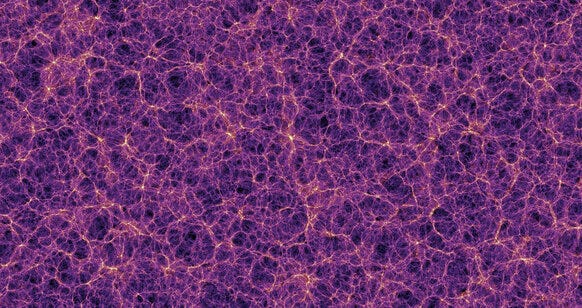A New Perspective on Dark Matter: Exploring Dark Photons
Written on
Chapter 1: The Cosmic Web and Dark Matter
The universe is an expansive entity filled with countless galaxies, both large and small. These celestial bodies are scattered across vast voids that can never be fully occupied. However, these enormous gaps are interconnected by an intricate cosmic web made up of filaments.
As the universe cooled following the Big Bang, much of its matter, particularly dark matter, solidified into filaments that encircle the cosmos. Some areas of this web accumulated more mass, leading to the formation of stars, galaxies, and clusters.
An advanced instrument aboard the Hubble Space Telescope, known as the Cosmic Origin Spectrograph (COS), has accurately gauged the temperature of this cosmic web. Yet, the actual measurements do not correspond with the expected temperatures derived from computer simulations regarding the universe's origins.
Galaxies, clusters, and cosmic voids within this web can be heated through various processes, including star formation, galactic winds, and magnetic activity. However, the heating method relevant to our discussion is effective even in low-density regions, with dark photons appearing to play a crucial role.
Dark photons could transform into low-frequency photons, thereby raising the temperature of cosmic structures. This phenomenon may provide a solution to the experimental observations— a theory put forth by researchers James S. Bolton (University of Nottingham), Andrea Caputo (CERN and Tel Aviv University), Hongwan Liu (New York University), and Matteo Viel (SISSA).

Section 1.1: Understanding Dark Photons
Dark matter is termed "dark" because it does not interact with light; ironically, we seek answers through photons, the very particles of light. Dark photons, which are theorized to exist, present a perplexing aspect of dark matter.
As explained by researchers Bolton, Caputo, Liu, and Viel, dark photons are proposed new particles that would act as the force carriers for a distinct force in the dark sector, akin to how photons mediate electromagnetism. Unlike regular photons, these particles can possess mass, particularly the ultralight dark photon, which may weigh as little as twenty orders of magnitude less than an electron—making it a strong candidate for dark matter.
There is a possibility that dark photons and regular photons may interact similarly to various types of neutrinos, indicating that ultralight dark photons could be viable dark matter candidates. But what exactly is this new force in the dark sector?
In 2015, a group of Hungarian physicists, led by Attila Krasznahorkay, conducted research on dark photons, which are believed to carry the electromagnetic force of dark matter. They even claimed to have discovered a fifth force of nature during their investigations. However, this introduces the challenge of integrating this fifth interaction with the four fundamental forces currently recognized.
Section 1.2: The Quest for a Unified Theory
To comprehend why a unified theory of physics is essential, we should reflect on the early universe. As temperatures escalated, the electromagnetic and weak nuclear forces amalgamated into the "electroweak force." Subsequently, the strong nuclear force joined this duo until, just before the universe's inception, all forces converged with gravity.
Moreover, phenomena like black holes necessitate a unified theory, as they exhibit properties of both General Relativity (GR) and Quantum Field Theory (QFT).
Typically, any endeavor to create a unified physics theory would require a quantum environment where gravity is sufficiently potent to influence outcomes significantly. However, achieving such conditions remains a near impossibility today. To create black holes, the scale of the Large Hadron Collider would need to expand to the size of our solar system, a task that would demand nearly a century of experimentation.
This chaotic landscape—our inability to merge existing theories—hinders our understanding of significant astrophysical events and leads to errors in simulations derived from our most refined models, such as the standard model. In response, some theoretical physicists are exploring groundbreaking concepts like string theory and quantum gravity.
The investigation into cosmic filaments has typically focused on probing the small-scale properties of dark matter. In this case, however, researchers have utilized low redshift intergalactic medium data as a calorimeter for the first time, to ascertain whether existing heating processes can adequately account for the observed data. Their findings indicate a missing component, which they attribute to contributions from dark photons. — Matteo Viel.
Although galaxies will continue to recede from one another until reaching the threshold of the big freeze, their interactions will persist through these cosmic filaments.
These filaments exist as ionized gas, which is invisible. However, intergalactic gas can be detected by its absorption of light from bright background sources. Nevertheless, this does not clarify the mechanisms of gas dispersion.
We already conceptually recognize the filaments that constitute the cosmic web, as their existence is supported by computer simulations.
The research regarding the hypothesis that dark matter may consist of dark photons has been published in Physical Review Letters.
For additional updates, consider subscribing to my newsletter.
For those new to Medium, signing up through my referral link grants you unlimited access to all stories on the platform.
The first video titled "Are neutrinos dark matter? | Even Bananas" delves into the relationship between neutrinos and dark matter, exploring whether they could be a key component of the elusive substance.
The second video, "Dark Matter: The Elusive Fibers of the Universe - Xuejian Shen," discusses the complex nature of dark matter and the implications of recent findings on our understanding of the universe.
Reference: James S. Bolton, Andrea Caputo, Hongwan Liu, and Matteo Viel. "Comparison of Low-Redshift Lyman-α Forest Observations to Hydrodynamical Simulations with Dark Photon Dark Matter." Physical Review Letters, 129, 211102 – Published 18 November 2022 DOI: 10.1103/PhysRevLett.129.211102